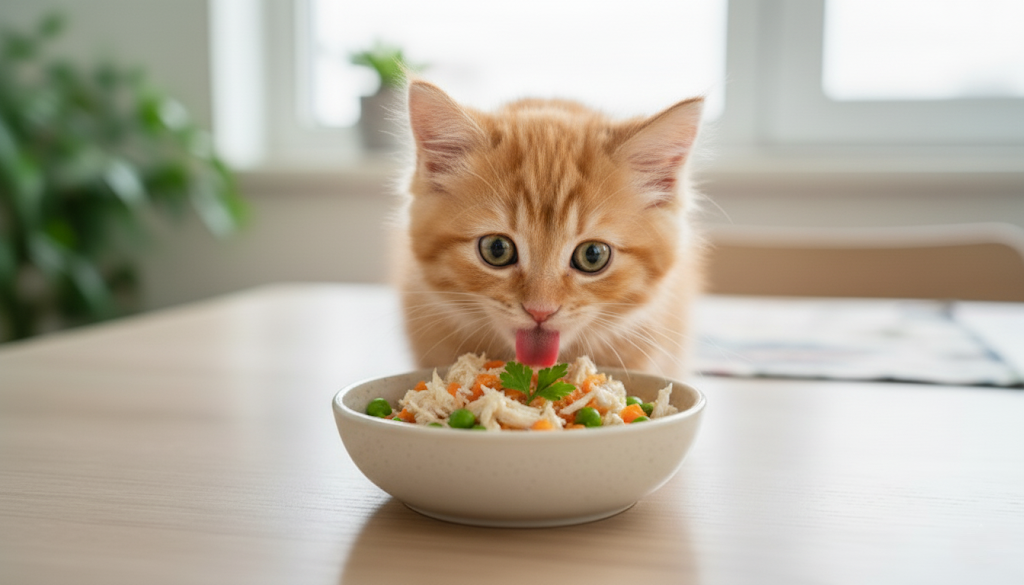
Welcoming a cat into your life often comes with one recurring question: Am I feeding them the best diet possible? Many cat parents explore homemade cat food recipes as an alternative to commercial products, hoping to improve digestion and promote a shinier coat. But making your own cat food isn’t as simple as cooking a piece of chicken. Done wrong, it can harm your cat. Done right, it can be safe, balanced, and even vet-approved.
In this post, I’ll break down the benefits, risks, and safe homemade cat food recipes vet approved, so you can make informed choices for your feline friend.
Homemade Cat Food Isn’t Always Healthier — Here’s the Science
Before you grab your apron and start mixing, it’s vital to understand a cat’s unique nutritional needs. Unlike dogs, cats are obligate carnivores. This means their diet must be centered around animal sources to get all the nutrients they need to thrive.
Key requirements include:
- High-quality protein (chicken, turkey, rabbit, fish, or beef).
- Taurine, an amino acid critical for heart and eye health.
- Essential fatty acids, which promote skin and coat health.
- Vitamins and minerals, especially calcium, phosphorus, and vitamin D.
This is why a recent study published in the Journal of the American Veterinary Medical Association is so critical. It found that over 80% of DIY cat food recipes online were nutritionally incomplete. This highlights the danger of improvising and why you should always follow vet-approved guidelines for your cat’s diet.
The Hidden Dangers of Homemade Cat Food — and How to Avoid Them
Homemade diets sound healthier, but they also carry risks:
- Nutrient Imbalance: Too much liver can lead to vitamin A toxicity, while too little calcium can cause brittle bones.
- Bacterial Contamination: Raw diets can expose both cats and humans to harmful bacteria like Salmonella or E. coli.
- Digestive Upset: Sudden changes to a diet can cause digestive issues like diarrhea or vomiting.
Essential Steps for a Safe Homemade Diet
- Work with a professional. Partner with a vet or a certified pet nutritionist to design a nutritionally complete recipe.
- Transition slowly. Introduce any new diet gradually, mixing it with your cat’s current food to prevent digestive upset.
- Supplement wisely. Use vet-approved supplements, especially for crucial nutrients like taurine and calcium.
- Lightly cook meat. A quick, light cook can kill harmful bacteria without destroying key nutrients.
Now, before you decide whether to go all-in with homemade meals or stick to packaged products, let’s compare the two side by side.
Homemade or Commercial Cat Food? Pros, Cons, and How to Choose What’s Right
| Factor | Homemade Cat Food | Commercial Cat Food |
|---|---|---|
| Nutrition | Can be balanced if vet-approved, but risk of deficiencies if done incorrectly. | Usually complete and balanced (AAFCO/WSAVA standards), but quality varies by brand. |
| Control of Ingredients | Full control over protein sources, additives, and freshness. | Limited transparency — fillers, preservatives, or low-grade protein in some brands. |
| Convenience | Time-consuming to prepare and store. | Extremely convenient — just open and serve. |
| Cost | Can be cost-effective if sourced smartly, but supplements may raise expenses. | Wide price range — from budget kibble to premium options. |
| Safety | Risk of bacterial contamination if handling raw meat. | Typically safer due to strict manufacturing standards. |
| Customization | Recipes can be tailored to your cat’s health needs (e.g., digestion, coat). | Limited customization unless using prescription diets. |
| Variety | Easy to rotate proteins and textures. | Wide variety of flavors and specialized formulas already available. |
👉 Bottom Line:
- Go homemade if you want ingredient control and are willing to invest time (with your vet’s help).
- Stick to commercial if convenience and guaranteed nutrition matter most.
- A hybrid approach — mixing high-quality commercial food with occasional homemade meals — often gives the best of both worlds.
Cat Food on a Budget: Comparing Monthly Costs of Homemade vs. Store-Bought
Nutrition and convenience aside, cost is one of the biggest deciding factors for cat owners. Here’s a closer look at the estimated monthly expenses in Malaysia:
| Feeding Type | Estimated Monthly Cost (RM) | Notes / Sources |
|---|---|---|
| Homemade (meat only) | RM 100–150 | Raw ingredients only, but nutritionally incomplete |
| Homemade + Supplements | RM 140–230 | Balanced diet with taurine, calcium, vitamins (Caticles) |
| Commercial – Dry only | RM 25–40 | Budget to mid-range kibble (Pottycats) |
| Commercial – Wet only | RM 60–120 | Cans/pouches; varies by brand |
| Commercial – Mixed feeding | RM 70–100 | Common choice: dry + wet |
Key Insight:
- Homemade diets are generally 2–3 times more expensive than budget to mid-range commercial feeding.
- Supplements are the hidden cost of homemade meals — they’re non-negotiable if you want balanced nutrition.
- Many cat owners find the mixed feeding model to be the sweet spot between affordability, convenience, and variety.
Affordable Homemade Cat Food Recipes Using Ingredients You Can Buy Locally
Here are some sample recipes designed with feline nutrition in mind. These are starting points — always adapt with your vet’s advice.
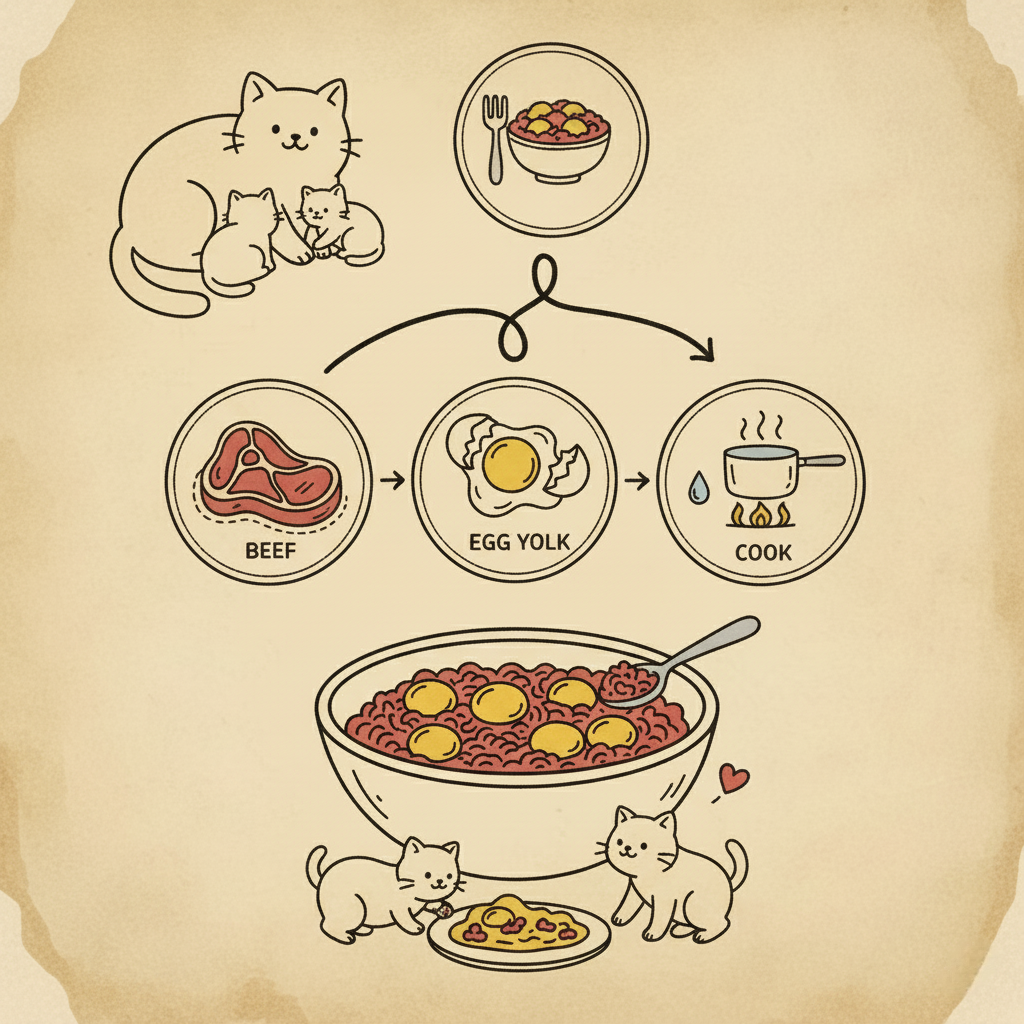
Beef and Egg Yolk Recipe
(for Kittens and Nursing Cats)
- 300g lean beef
- 200g chicken breast
- 4 egg yolks
- 12g eggshell powder
- 2g taurine powder
Directions
- Dice the beef and chicken breast, and soak in water for 10 minutes to remove blood.
- Place the meat in a pot with cold water. Bring to a boil over high heat, then reduce to a simmer and cook for 15 minutes to ensure the meat is fully cooked.
- Mash the egg yolks and mix them with the cooled meat. Use a food processor to blend the mixture into a fine paste for easy swallowing.
- Add the eggshell powder and a daily portion of taurine powder (approximately 0.3g) to the paste and mix thoroughly.
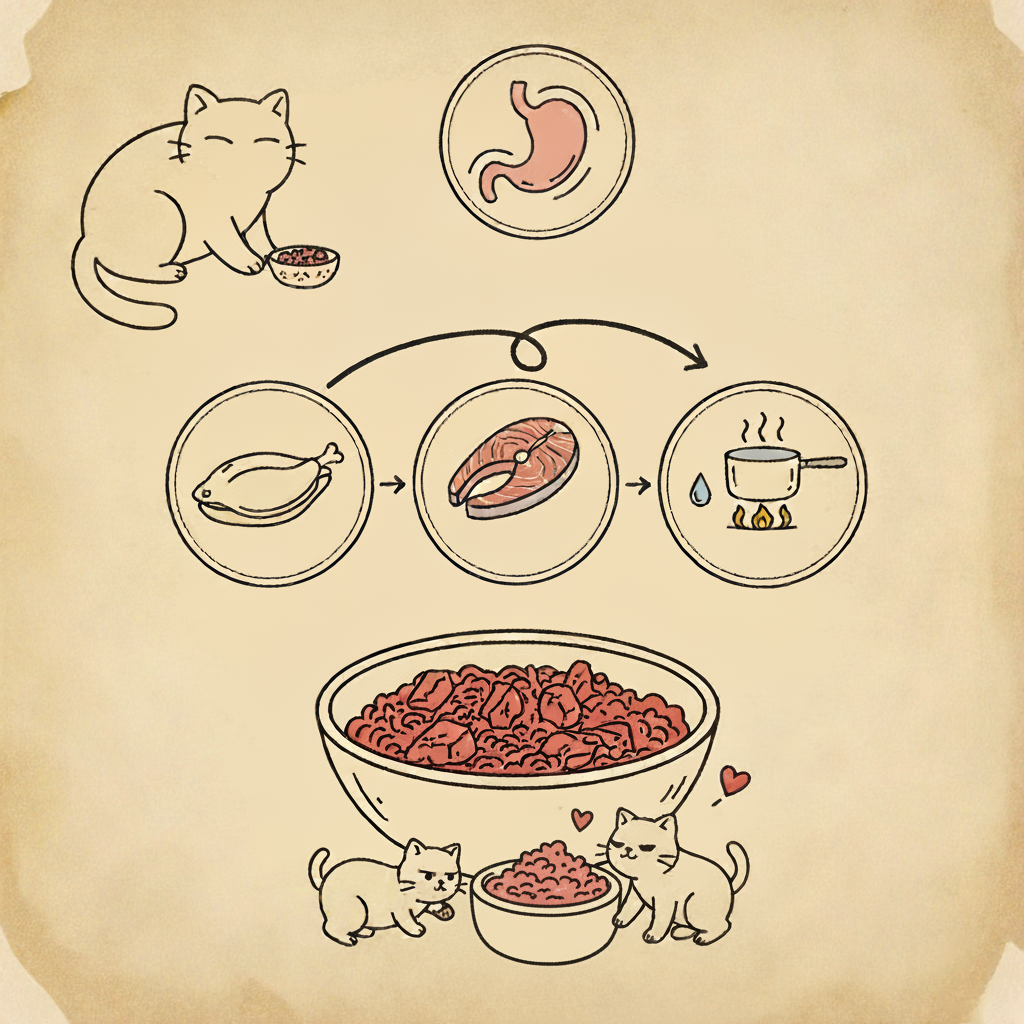
Duck and Salmon Recipe
(for Cats with Sensitive Stomachs)
Ingredients
- 400g duck breast
- 100g salmon scraps
- 50g chicken hearts
- 8g eggshell powder
- 1.5g taurine powder
Directions
- Wash the duck breast, salmon, and chicken hearts. Clean the salmon by removing any scales and small bones to prevent your cat from choking.
- Place all three types of meat in a steamer.
- Once the water boils, steam for 15 minutes to ensure the meat is fully cooked.
- Let the steamed meat cool, then chop it into small pieces. Add the eggshell powder and a daily portion of taurine powder (about 0.2g), then mix well.
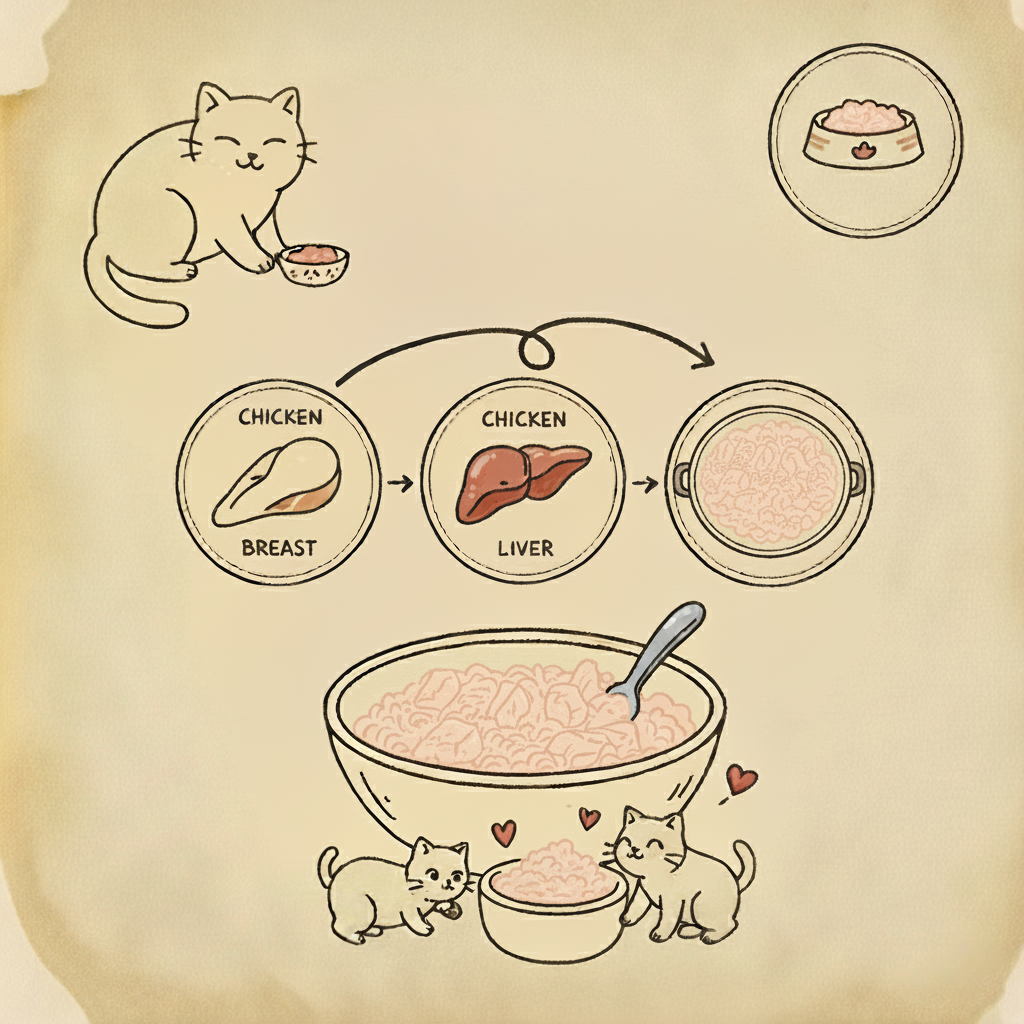
Classic Chicken Recipe
(for Healthy Adult Cats)
Ingredients
- 500g chicken breast
- 50g chicken liver
- 3 egg yolks
- 10g eggshell powder
- 2g taurine powder
recipes for demonstration only. Always consult a vet for a complete, balanced homemade diet plan.
Directions
- Wash and chop the chicken breast. Soak the chicken liver in water for 30 minutes to remove blood and reduce its gamey smell. Boil the eggs and set aside the yolks.
- Place the chicken breast and chicken liver separately in a pot with cold water and cook for 10 minutes until fully done, ensuring there is no pink meat.
- Let all ingredients cool down. Use a food processor to chop them into small pieces or mince by hand, adjusting according to your cat’s chewing ability.
- Add the eggshell powder and a daily portion of taurine powder (approximately 0.3g) to the food and mix well.
Practical Feeding Tips
- Frequency: Most adult cats do best with 2–3 meals per day.
- Portion control: Watch your cat’s weight closely. Overfeeding is common with homemade diets.
- Storage: Keep meals in airtight containers and refrigerate (max 48 hours).
- Rotation: Rotate protein sources to prevent boredom and nutrient gaps.
Homemade Cat Food Recipes: Frequently Asked Questions
How do I safely transition my cat to a new food?
Transition your cat gradually over 7–10 days by mixing small amounts of the new food with the old one. Increase the new food portion slowly to avoid stomach upset or food refusal.
Is there Halal-certified cat food available in Malaysia?
Yes. Brands like Powercat offer Halal-certified cat food, ensuring no pork or non-Halal meat is used. Always check packaging labels for certification.
What is the right homemade food ratio for cats to ensure balanced nutrition?
A common guideline is around 70–80% animal protein, 5–10% vegetables, and the rest healthy fats, oils, and water. Supplements may be needed to cover essential vitamins and taurine.
How should I store dry and wet cat food in Malaysia’s hot and humid weather?
Keep dry food in airtight containers away from heat and moisture. Once opened, wet food should be refrigerated and used within 2–3 days.
Which cat food options are suitable for cats with sensitive stomachs in Malaysia?
Look for easily digestible wet food with limited ingredients, such as chicken or fish formulas. Local options like Tryfurball and Pawcipes are often recommended by cat owners.
Conclusion: Should You Try Homemade Cat Food?
If done with proper planning and vet-approved guidance, homemade diets can improve digestion and promote a shinier coat. However, this isn’t a casual DIY project. Cats have strict dietary needs, and shortcuts can lead to serious health problems.
For most owners, a combination approach works best: high-quality commercial cat food as a base, supplemented with carefully prepared homemade meals. This way, your cat enjoys variety without risking deficiencies.
✨ Curious about other cat nutrition topics? Check out [Kitten to Cat Food] for a guide on kitten diets and [New Cat Owners] for raw food feeding tips.
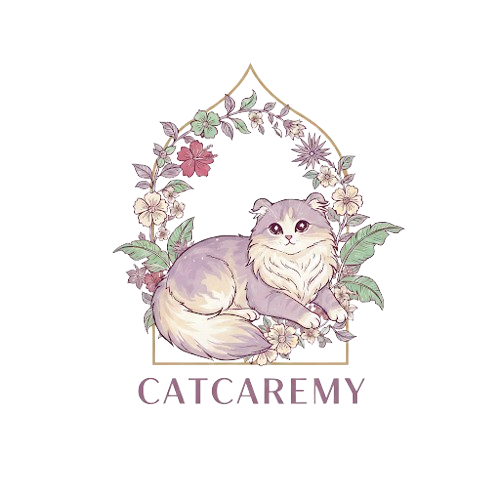
[…] If you’re interested in a DIY approach but worried about risks, check our guide on [safe homemade cat food recipes vet-approved). […]